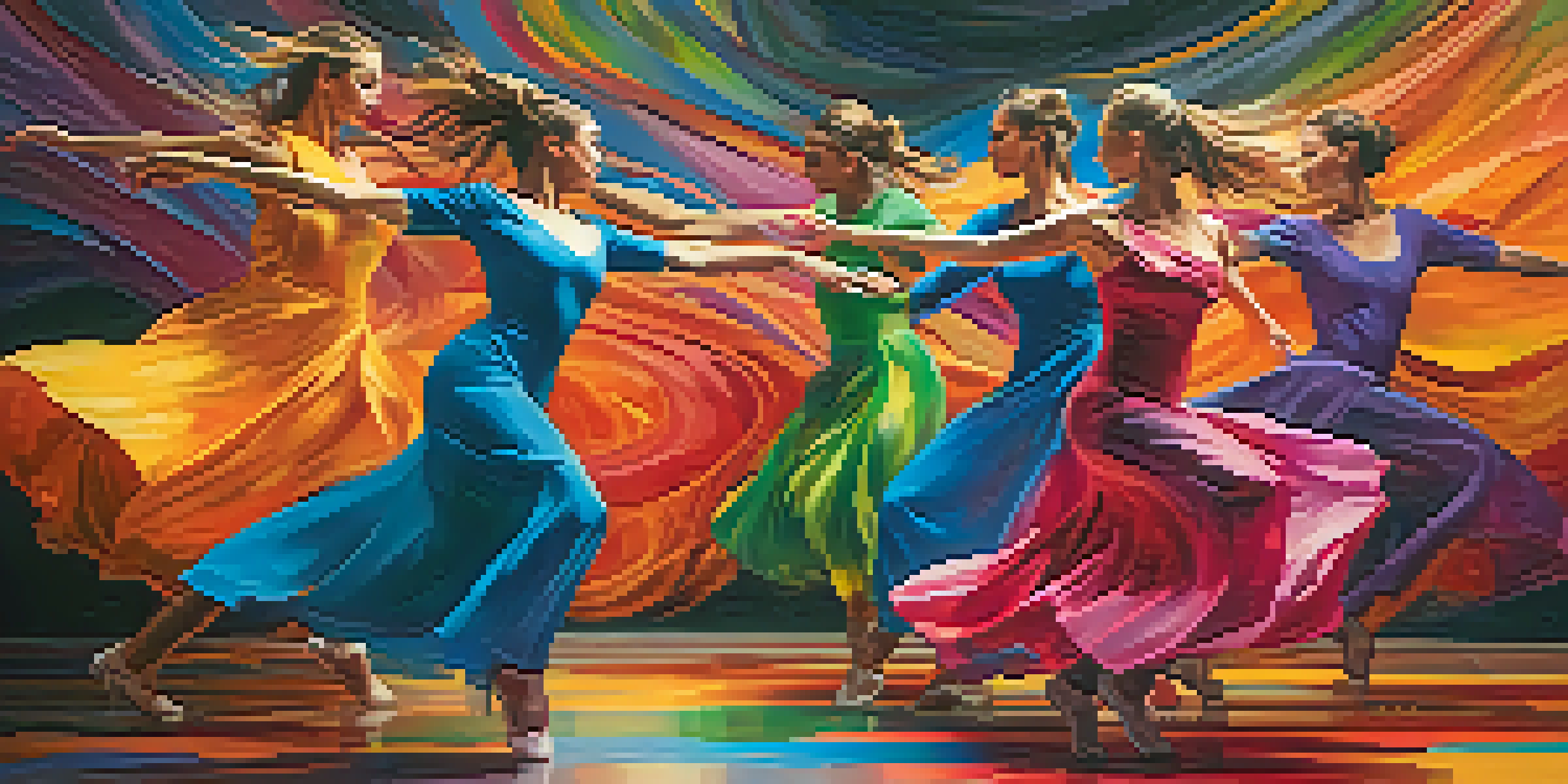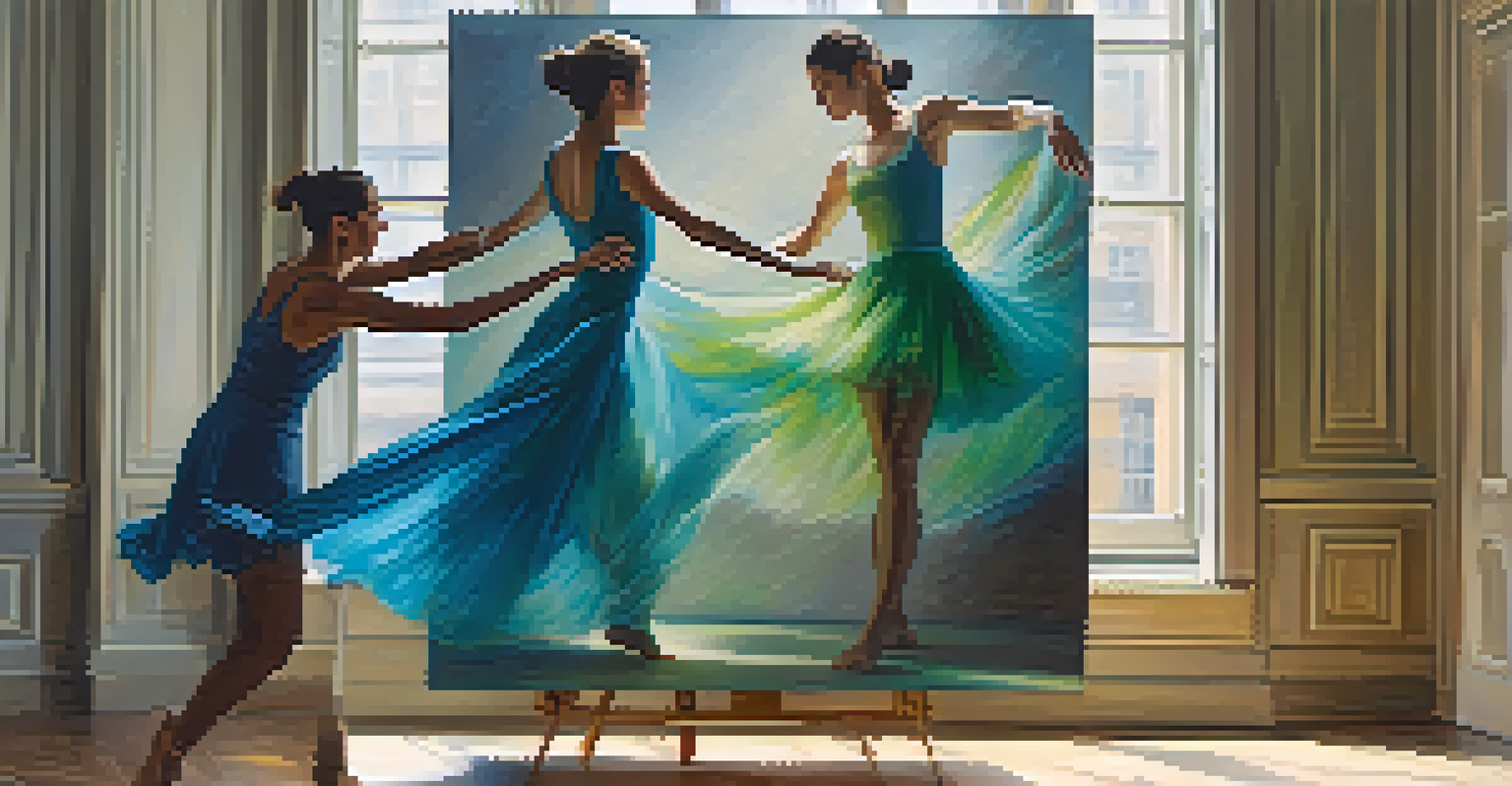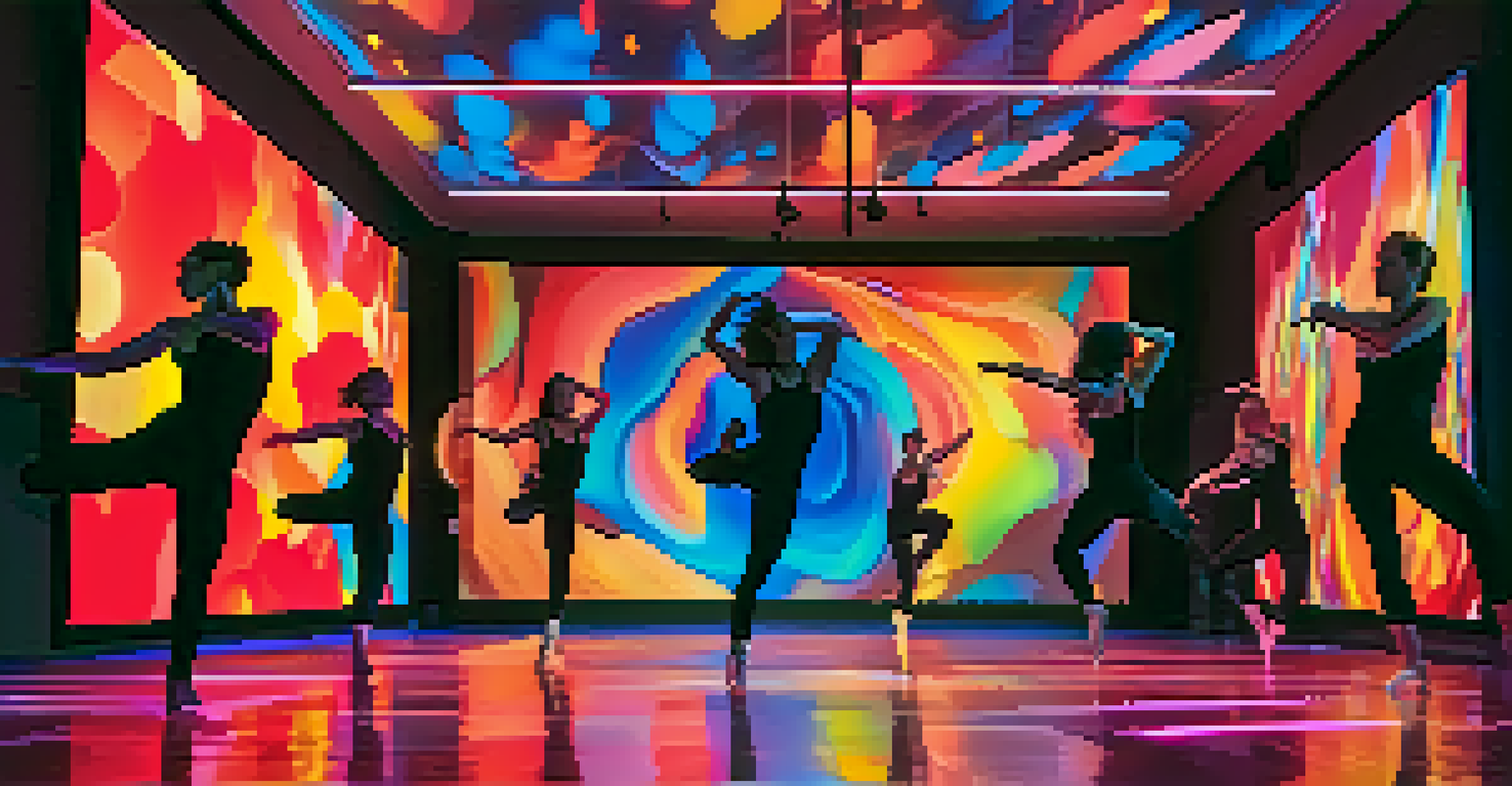The Fusion of Dance and Painting: A Collaborative Approach

Understanding the Relationship Between Dance and Painting
Dance and painting may seem like separate worlds, but they share a deep connection rooted in expression. Both forms of art communicate emotions, stories, and ideas, often transcending language. For instance, a dancer's movement can evoke feelings that a painter captures on canvas, creating a dialogue between the two art forms.
Dance is the hidden language of the soul.
Think of a lively dance performance where each twirl and leap embodies the essence of a vibrant painting. Just like brush strokes can convey energy and rhythm, movements in dance can mirror the shapes and colors on a canvas. This synergy invites artists from both disciplines to explore their creativity together.
By combining dance and painting, artists can enhance their ability to tell stories. The fluidity of dance amplifies the visual impact of painting, while the visual elements inspire more dynamic choreography. This collaborative approach allows for a richer sensory experience, engaging audiences in unique and memorable ways.
Historical Collaborations: Dance Meets Painting
Historically, the fusion of dance and painting has produced some remarkable collaborations. One notable example is the work of artists like Wassily Kandinsky, who sought to express movement through color and form, often finding inspiration in dance. His paintings resonate with the rhythm and dynamism of a live performance, blurring the lines between the two art forms.

In more contemporary settings, performances like 'The Painted Dance' showcase how dancers use painted props or even body paint to create a living artwork. These performances often invite viewers to witness the transformation of both the dancers and the space, as the visuals evolve with the movements. This interplay highlights how the two arts can complement and elevate each other.
Art Forms Share Deep Connections
Dance and painting communicate emotions and stories, creating a unique dialogue between the two.
Such historical collaborations remind us that artists have always been inspired by one another. The exchange between painters and dancers not only pushes their respective boundaries but also enriches our understanding of both disciplines. This legacy continues to influence modern artists, encouraging new forms of expression.
The Creative Process: How Artists Collaborate
Collaboration between dancers and painters often begins with an exchange of ideas and visions. This brainstorming phase allows each artist to share their inspirations, leading to a shared understanding of the project. For example, a choreographer might describe the emotions they wish to convey, while a painter might suggest colors that resonate with those feelings.
Painting is just another way of keeping a diary.
Once the concept is established, the collaborative process can take various forms. Dancers may perform in front of large canvases being painted live, creating a visual representation of their movements in real-time. Alternatively, painters might create visuals that inspire choreographed pieces, resulting in a dynamic interplay between the two art forms.
This co-creation fosters an environment where both artists can experiment and take risks. They can learn from each other, blending techniques and styles to produce innovative works that challenge traditional boundaries. As a result, the audience is treated to a unique experience that showcases the power of artistic collaboration.
The Role of Technology in Dance and Painting Fusion
In today’s digital age, technology plays a pivotal role in enhancing the fusion of dance and painting. Artists are increasingly using projection mapping to display dynamic visuals that change with the dancers' movements. This technology allows for a mesmerizing experience, where paintings come to life, creating an immersive atmosphere.
For instance, performances may feature dancers moving against projected images that shift and morph, mirroring their actions. This synergy creates a multi-layered narrative, where the audience can see both the dance and the evolving artwork simultaneously. It’s almost like watching a painting emerge as the dance unfolds, highlighting the connection between the two.
Collaboration Enhances Artistic Expression
The fusion of dance and painting allows artists to experiment and innovate, resulting in richer storytelling.
Furthermore, social media platforms allow artists to share their collaborative projects with a global audience. This visibility not only inspires other artists but also connects them with potential collaborators. Technology, therefore, acts as a catalyst, bringing together diverse talents to explore new frontiers in the arts.
Audience Engagement: The Impact of Collaborative Art
The collaboration between dance and painting offers audiences a unique way to engage with art. By combining these two forms, viewers can experience a rich tapestry of visual and movement-based storytelling. This immersive experience often evokes a range of emotions, allowing audiences to connect with the art on multiple levels.
For example, attending a performance where dancers interpret a painted scene can leave a lasting impression, as audiences witness the narrative unfold before their eyes. The combination of sight and motion enhances the storytelling, making it more accessible and relatable. This emotional engagement encourages viewers to reflect on their own experiences and interpretations.
Moreover, interactive installations that invite audience participation can deepen this connection. When viewers can step into a space where dance and painting coexist, they become part of the art itself. This active involvement fosters a sense of community and shared experience, emphasizing the power of collaborative art.
Challenges in Merging Dance and Painting
While the fusion of dance and painting is captivating, it does come with its own set of challenges. One significant hurdle is the differing perspectives and techniques that each artist brings to the table. Dancers often focus on movement and physical expression, while painters may prioritize color and composition, which can lead to misunderstandings.
Additionally, logistical issues such as space, timing, and resources can complicate collaborative projects. For instance, coordinating rehearsals and painting sessions requires careful planning to ensure both artists can work harmoniously. This complexity can be daunting but also serves as an opportunity for growth and innovation.
Technology Boosts Creative Collaborations
Modern technology, like projection mapping, enhances the synergy between dance and painting, creating immersive experiences.
Despite these challenges, many artists find that the rewards of collaboration far outweigh the obstacles. By overcoming differences and embracing each other's strengths, they can create works that are truly unique. This process of negotiation and adaptation ultimately leads to richer artistic expressions.
The Future of Dance and Painting Collaboration
As we look to the future, the collaboration between dance and painting is poised to evolve even further. Artists are continually experimenting with new styles, techniques, and technologies, pushing the boundaries of what is possible. This ongoing exploration invites a new generation of artists to engage in the conversation and contribute their unique perspectives.
Moreover, the rise of interdisciplinary art forms encourages a blending of not just dance and painting, but also other mediums like sculpture, music, and digital art. Such collaborations can lead to innovative performances that challenge conventional definitions of art. The result is a vibrant landscape where creativity knows no bounds.

Ultimately, the fusion of dance and painting underscores the idea that art is a collaborative journey. As artists continue to inspire one another, we can expect to see even more breathtaking works that resonate with audiences on an emotional level. This journey not only enhances the art forms themselves but also enriches the cultural tapestry of our society.